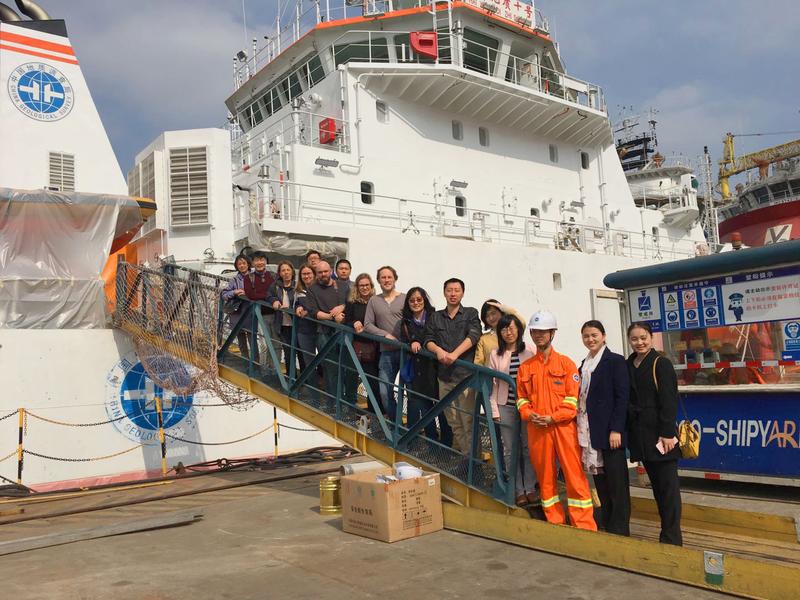

German-Chinese kick-off meeting in Guangzhou on the research vessel HAIYANG 10: Joanna Waniek (3. f. l.) is the head coordinator of the research regarding the fingerprint of megacities in the sea.
IOW
The largest cities of the world can be found in China. When the number of inhabitants exceeds 10 million, those cities are referred to as ‘megacities’. There are plans underway to create even larger conurbations with 10 times as many citizens by merging already existing megacities. Examples are the region at the mouth of the Yellow River in Eastern China and the Guangzhou / Hong Kong region in the South at the Pearl River mouth.
Here, more than 100 million people will inhabit an area 100 times as big as London in one huge conurbation. How will the effluents of such immensely big cities, which carry various problem substances such as pharmaceuticals and microplastic particles, impact receiving waters, rivers, and coastal seas? How will the on-going fast population growth further influence the pollution of these waters?
Those are central questions of the two joint projects MEGAPOL (short for “Megacity’s fingerprint in Chinese marginal seas: Investigation of pollutant fingerprints and dispersal”) and TRAN (short for “Temporal pattern of anthropogenic and natural particles at the slope of South China Sea”) coordinated by IOW.
The project MEGAPOL will focus on the Pearl River mouth area in the South China Sea as well as the Yellow River delta in the Bohai Sea. With an interdisciplinary approach the project aims at understanding the anthropogenic environmental change in these coastal waters and how its impact spreads into deeper oceanic regions.
Both study areas are ideal model systems – not only because of the neighbouring megacities, but also because they provide a good opportunity to study exchange processes between land and ocean in very sensitive marine ecosystems and the changes in the physical driving forces behind these processes such as monsoon, marine currents as well as impacts of climate change.
The TRAN project augments the scientific angle of MEGAPOL as well as its infrastructure by deploying a contamination free mooring at the northern continental slope of South China Sea in the area affected by the Pearl River plume. Put into position in spring 2018, the mooring will record the temporal patterns of anthropogenic and natural particles. The key challenge is to construct and install the complex 2000 metre device with its numerous instruments in a way that guarantees a reliable distinction between the two particle types. During an expedition with the German research vessel SONNE in summer 2019 the mooring will be hauled in for a first sample and data recovery.
An intensive exchange between the German and Chinese scientists as well as a close cooperation regarding the field work are an integral part of both projects. Chinese MEGAPOL partners are the Second Institute of Oceanography SOA in Hangzhou, the National Marine Environmental Monitoring Centre in Dalian, the Yantai Institute of Coastal Zone Research, CAS, the Shanghai Jiao Tong University and the Guangzhou Marine Geological Survey. Besides IOW, which heads the investigations, the German project partners are the University of Hamburg with its institutes of Oceanography and for Geology as well as the Helmholtz-Zentrum Geesthacht’s Institute of Coastal Research.
Prof. Dr. Joanna Waniek (IOW), head coordinator of both projects, is very pleased by the kick-off meeting’s outcome: “We prepared the first joint expedition in September 2018 and determined cruise routes as well as sampling methods.” Her colleague, Prof. Zhou Meng of Shanghai Jiao Tong University, who coordinates the Chinese project tasks, adds: “We scheduled the measurements in the Pearl River estuary and made detailed plans for the exchange and the training of our PhD students.” “The planning is ambitious but we all are very much looking forward to the scientific and the cultural challenges,” says Joanna Waniek.
All participants expect that the close German-Chinese cooperation will bring additional momentum and synergies to the joint research. Joanna Waniek: “In Germany, our cities are growing as well and the pressure of human impact on coastal seas is rising. We therefore should regard the anthropogenic fingerprints, which we expect to find in the sediments of South China Sea, as strong warning signals.”
Scientific contact::
Prof. Dr. Joanna Waniek | +49 (0)381 5197 300 | Joanna.waniek@io-warnemuende.de
Press and Public Relations at IOW:
Dr. Kristin Beck | Phone: +49 (0)381 – 5197 135 | kristin.beck@io-warnemuende.de
Dr. Barbara Hentzsch | Phone: +49 (0)381 – 5197 102 | barbara.hentzsch@io-warnemuende.de
IOW is a member of the Leibniz Association with currently 91 research institutes and scientific infrastructure facilities. The focus of the Leibniz Institutes ranges from natural, engineering and environmental sciences to economic, social and space sciences as well as to the humanities. The institutes are jointly financed at the state and national levels. The Leibniz Institutes employ a total of 18.100 people, of whom 9.200 are scientists. The total budget of the institutes is 1.6 billion Euros. (http://www.leibniz-association.eu)











